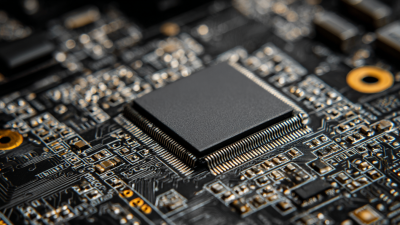Master the Art of Circuit Design Software for Innovative Electronics Solutions
In today's rapidly evolving electronics landscape, mastering circuit design software has become essential for engineers and designers seeking innovative solutions. According to a recent industry report by MarketsandMarkets, the global electronic design automation (EDA) market, which includes circuit design software, is projected to reach $16.2 billion by 2026, growing at a CAGR of 8.3% from 2021. This growth is driven by the increasing complexity of electronic systems and the demand for high-performance, low-power designs. As the Internet of Things (IoT) and Artificial Intelligence (AI) continue to expand, the ability to effectively utilize circuit design software will empower professionals to implement advanced functionalities and improve design efficiency. Embracing these tools not only streamlines the design process but also fosters innovation, facilitating the development of cutting-edge electronic solutions that meet the market's ever-evolving needs.

Understanding the Fundamentals of Circuit Design Software
Circuit design software is essential for anyone looking to create innovative electronics solutions. Understanding the fundamentals of this software enables engineers to simplify complex designs and enhance their creativity. By mastering these tools, you can easily simulate circuits, analyze performance, and debug issues before physical prototyping, saving time and resources in the development process.
**Tip:** Familiarize yourself with the user interface of your chosen circuit design software. Spend time exploring its features, as a strong grasp of the layout will streamline your workflow significantly. Utilize built-in tutorials and resources to enhance your learning experience.
Moreover, always prioritize good documentation practices within your circuit designs. An organized approach helps not only in the current project but also assists other team members or future iterations. Label components clearly and maintain a consistent naming convention for better understanding and collaboration.
**Tip:** Regularly back up your files and version your designs. This not only protects against data loss but also allows you to revert to previous versions if needed, making troubleshooting much more manageable.
Exploring Different Types of Circuit Design Tools and Their Applications
In the ever-evolving field of electronics, selecting the right circuit design tool can greatly influence the outcome of your projects. There are various types of circuit design software available, each catering to different needs—from beginner-friendly platforms to advanced simulation tools used by professionals. Tools like LTSpice and TINA-TI allow for easy simulation of analog circuits, whereas software such as Altium Designer and Eagle focuses on PCB design, enabling users to create intricate layouts for complex systems.
**Tip:** Before diving into a specific software, assess your project's requirements carefully. Simplicity is key for small projects, while larger, more complex designs benefit from tools with extensive features and support.
For digital circuit design, tools like Logisim and Xilinx ISE offer a fantastic environment for creating and testing logic circuits. These applications provide an interactive interface that enhances understanding through visual representation. By experimenting with these programs, designers can foster creativity and innovation in their electronic solutions.
**Tip:** Don’t hesitate to explore trial versions of multiple tools. Experimentation helps identify which software aligns best with your workflow and offers the features you need without the upfront investment.
Master the Art of Circuit Design Software
This bar chart illustrates the distribution of popular circuit design software used in the electronics industry, showcasing their application areas.
Key Features to Look for in Circuit Design Software
When venturing into the world of circuit design software, focusing on key features can significantly enhance your experience and effectiveness. One critical attribute to consider is user interface usability. A well-designed UI can streamline your workflow and minimize the learning curve, allowing you to focus on your innovative electronics solutions rather than getting bogged down in complex software navigation.
Another essential feature to look for is the software’s simulation capabilities. The ability to test and simulate your circuit designs before physical implementation can save both time and resources. Robust simulation tools allow you to predict performance, troubleshoot potential issues, and make informed adjustments, leading to better overall designs.
**Tips:** When evaluating circuit design software, prioritize options with extensive libraries for components and materials. This will ensure you have access to the latest technology and can experiment with various configurations. Additionally, consider if the software supports collaboration features; working with a team can drive innovation and enhance the creative process in circuit design.
Integrating Circuit Design Software with Hardware Solutions
 Integrating circuit design software with hardware solutions is essential for developing innovative electronic products. The intricate process of designing an analog ASIC is a prime example of this integration. ASICs serve specific functions and are crucial for devices ranging from smartphones to industrial machinery. The application of advanced software tools offers designers an unparalleled capability to create precise models and simulations, ultimately leading to more efficient design cycles.
Integrating circuit design software with hardware solutions is essential for developing innovative electronic products. The intricate process of designing an analog ASIC is a prime example of this integration. ASICs serve specific functions and are crucial for devices ranging from smartphones to industrial machinery. The application of advanced software tools offers designers an unparalleled capability to create precise models and simulations, ultimately leading to more efficient design cycles.
Tips: When selecting CAD software, consider the software’s compatibility with existing hardware systems. Ensuring smooth integration can significantly reduce time-to-market for new products. Moreover, adopting AI-driven tools can enhance verification processes by transforming them from reactive to proactive, thereby improving overall productivity.
Recent analyses indicate that companies leveraging AI technologies in their design processes can improve efficiency by over 30%. As industries increasingly embrace this technological shift, partnerships between leading software developers and hardware manufacturers will be key. Staying informed about the latest advancements and investing in the right tools will empower engineers to meet the growing demands for speedy and innovative solutions.
Best Practices for Effective Circuit Design and Innovation
 Effective circuit design is vital for driving innovation in electronics, as detailed in the "2023 Electronics Design Trends" report by IDC, which indicates that 68% of companies prioritizing advanced circuit design tools have significantly improved their project turnaround times. Efficient software solutions streamline the design process by enabling simulation, optimization, and rapid prototyping, thereby reducing the likelihood of costly errors late in the development cycle.
With up to 30% of resources in engineering teams often spent on redesigning faulty circuits, leveraging robust software can lead to substantial cost savings and enhanced productivity.
Effective circuit design is vital for driving innovation in electronics, as detailed in the "2023 Electronics Design Trends" report by IDC, which indicates that 68% of companies prioritizing advanced circuit design tools have significantly improved their project turnaround times. Efficient software solutions streamline the design process by enabling simulation, optimization, and rapid prototyping, thereby reducing the likelihood of costly errors late in the development cycle.
With up to 30% of resources in engineering teams often spent on redesigning faulty circuits, leveraging robust software can lead to substantial cost savings and enhanced productivity.
To foster innovation, best practices in circuit design include comprehensive simulations that account for real-world conditions, user-friendly interfaces that facilitate collaboration among team members, and integration with PCB design tools. The 2022 IEEE survey revealed that organizations employing integrated design environments reported a 50% increase in development speed and a 40% reduction in design flaws. By investing in top-tier circuit design software and adhering to these best practices, engineers can not only develop groundbreaking electronic solutions but also position their companies at the forefront of the competitive electronics landscape.



